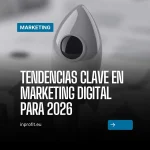Setting up a basic online store with WordPress and WooCommerce is relatively simple. The real challenge lies in building advanced online stores, ready to scale, automate processes, integrate with other systems and convert visits into sales in a predictable way.
This is exactly what many companies and SMEs are looking for today: to go from “having a website that sells something” to having a powerful, measurable and truly optimized digital asset.
What do we mean by “advanced online store”?
Before we talk about plugins and designs, we need to ground the concept.
A advanced online store with WordPress and WooCommerce is not just a pretty catalog. It usually meets, at least, these characteristics:
- Adapts to the business model (B2C, B2B, D2C, subscription, mixed).
- It has an optimized purchase flow: few steps, no friction and designed for mobile.
- Integrates marketing automations (abandoned carts, cross-selling, remarketing).
- Connects with other company systems: ERP, CRM, invoicing, logistics.
- It is designed to scale: performance, hosting, security and data architecture.
- Everything is measured: funnel, customer cohorts, lifetime value (LTV), cost of acquisition (CAC), etc.
If your current store only “receives orders” but you have no clarity on actual margin, recurrence or bottlenecks, it’s not advanced… yet.
If your WooCommerce already sells but you feel it has become too small, it’s time to think about a strategic leap, not just “put more plugins on it”.
Strategic pillars before touching WordPress
Many stores are born backwards: first you install WordPress and then you decide what to sell. To create an advanced online store, the sequence is just the opposite.
1. Define the business model and the catalog.
- Do you sell to companies, end consumers or both?
- Physical product, digital, services or bundles?
- Do you need complex variations (sizes, colors, configurators) or simple products?
The way you build the product database in WooCommerce will depend on these answers. A bad initial architecture is very expensive when you have hundreds or thousands of references.
2. Buyer persona and purchase paths
An advanced store is designed with the user in mind:
- Where do they discover you from (SEO, campaigns, networks, marketplaces…)?
- What questions do you have before you buy?
- Do you need comparisons, calculators, simulators, demos?
Answering these questions will help you define category structures, filters and content (guides, in-depth tabs, FAQs) that really drive conversion.
3. Internal operations and logistics
WooCommerce can connect with virtually anything, but you have to design the flow:
- How do orders enter your system?
- Who manages the stock and where is the inventory truth?
- What carriers do you use and how are freight charges calculated?
The more advanced you want your online store to be, the more important it is to align business, operations and technology from minute one.
Technical architecture in WordPress and WooCommerce
We move on to the part that many want to start first: the technical part. This is where the future of the store is won (or lost).
Choice of stack: hosting, theme and builder
For advanced stores, it is advisable to avoid “everything for free”:
- Managed WordPress hosting with good CPU, SSD/NVMe disks and caching systems.
- Updated PHP, latest stable version of WordPress and WooCommerce.
- A lightweight professional theme, well maintained and compatible with WooCommerce.
- Visual builder (if you use it) that does not increase the weight of the page: well worked Gutenberg, optimized Elementor, etc.
Investing well here avoids crashes, slowness and headaches when many visitors come in.
SEO structure: categories, attributes and URLs
An advanced store leverages WooCommerce for positioning:
- Categories with clear search intent.
- Filters based on attributes that also help SEO (brand, use, sector, material…).
- Clean, hierarchical and consistent URLs.
- Product sheets with worked content: benefits, use cases, FAQs, social proofs.
It’s not just about “getting on Google”, it’s about attracting qualified traffic that is actually close to buying.
Essential plugins… without falling into “plugin-dependency”.
One of the keys to create advanced online stores with WordPress and WooCommerce is to know how to say no to many plugins:
- It is better to use few plugins, but with quality, active support and well coded.
- Whenever you can, a lightweight custom development is worth more than 3 plugins that do the same thing half-heartedly.
- Periodically review what is used and what is left over.
Advanced functionalities that make the difference
This is where an advanced online store separates itself from a standard WooCommerce installation.
Intelligent filters and faceted search
In large catalogs, a basic search engine is not enough. Some key improvements:
- Predictive search with product, category and content suggestions.
- Dynamic filters (price, sector, compatibility, size…) that do not overload the entire page.
- Results sorted by relevance, margin or rotation (not only by name).
The easier it is to find the perfect product, the higher the conversion and average ticket.
WooCommerce for B2B: roles, rates and fast ordering
If you sell to businesses, an advanced online store needs:
- User roles with different pricing conditions (customer or group rates).
- Specific catalogs according to type of customer or country.
- Quick purchase options (Excel-like listings, repeat orders, templates).
- Payment methods adapted to B2B: transfer, deferred payment, credit limit.
WooCommerce can be a very powerful B2B platform if configured with this logic from the start.
Marketing automation and loyalty
The beauty of advanced eCommerce is automation and that it works for you even when you’re not there:
- Recovery of abandoned carts.
- Welcome flows for new customers.
- Automated upselling and cross-selling based on purchase history.
- Advanced segmentations (customers by volume, by category purchased, by margin).
This is where integrations with email marketing, CDP or CRM tools come into play.
ERP and CRM integrations
An advanced online store is rarely “alone”. It is usually connected with:
- ERP: stock, prices, invoices, purchases from suppliers.
- CRM: leads, opportunities, commercial follow-up, offline sales.
- BI or Data Studio tools: dashboards and reporting.
The important thing is to decide where the master data resides (e.g., stock in the ERP) and that WooCommerce syncs reliably.
Conversion and user experience optimization (CX)
It’s not just about making the store work; it has to sell as much as possible with the available traffic.
What should an advanced WooCommerce checkout look like?
Some principles that we apply over and over again:
- Checkout in one or two steps maximum.
- No distractions: no menus and elements that distract the user.
- Payment methods adapted to the country and the public: card, PayPal, Bizum, financing, one-click payment.
- Address auto-completion, fast data validation and clear error messages.
- Clear shipping options, no surprises at the end.
Small details in the checkout experience can lead to a noticeable increase in the conversion rate.
Performance, mobile and Core Web Vitals
Google and users punish slow stores, especially on mobile. That’s why an advanced store takes care:
- Optimized image weights and modern formats.
- Well configured caches (server and plugin).
- Moderate use of external scripts (tracking tags, chats, widgets…).
- Mobile first design, designed for fingers, not for mouse.
Improved speed directly impacts SEO, user experience and sales.
If you are thinking of investing heavily in traffic (Ads, SEO, marketplace), before scaling, it is advisable to have these technical bases polished. Otherwise, you will be paying for sending users to a leaky funnel.
How to manage and scale an advanced online store?
Once it’s up and running, the real game begins.
Ongoing technical maintenance
An advanced online store with WordPress and WooCommerce is not something that is “finished”:
- Periodic updates of core, plugins and theme.
- Security reviews, automatic backups, staging environments.
- Uptime and performance monitoring.
The objective is to minimize risks: a store failure in the middle of a campaign can cost a lot of money and reputation.
Key metrics for decision making
Beyond visits, an advanced store is managed with data:
- Conversion rate per channel.
- Average ticket and customer lifetime value.
- Acquisition cost per campaign.
- Star and anchor products.
- Full funnel: sessions → add to cart → checkout → purchase.
With this information, it is possible to prioritize improvements: sometimes it is more profitable to optimize a checkout step than to launch a new campaign.
Growth roadmap
There is no need to activate everything from day one. A logical strategy could be:
- Launch the store with a solid foundation (catalog, checkout, performance).
- Add marketing automations and lead generation.
- Integrate ERP/CRM when the volume of orders justifies it.
- Implement advanced B2B, multi-store or internationalization functionalities.
The important thing is to have a clear roadmap and not to go by plugin.
Ready to take your eCommerce to the next level?
Creating advanced online stores with WordPress and WooCommerce is not about installing more extensions, but about aligning strategy, technology and business.
When everything is well connected:
- You see the real impact of your campaigns in margin, not just in orders.
- Your internal processes are simplified rather than complicated.
- The team has control over catalog, pricing and promotions without relying on third parties.
- You can scale marketing investment with confidence because the store can keep up.
If right now you have a store that works “halfway”: it crashes, is slow, the control panel is a mess or you depend on a thousand excels to know what is going on, it is a clear sign that you need to make the leap to a more advanced approach.
At Inprofit, as a 360 marketing and new technologies agency, we work just at that point: transforming WooCommerce into the nerve center of your digital business. We design the strategy with you, organize the ecosystem of tools, optimize the user experience and prepare your eCommerce to grow without losing control or profitability.
If you want:
- Check if your current store is ready to scale.
- To plan a new advanced online store from scratch.
- Or simply understand what you could do better to sell more with the same traffic…
We invite you to book a session with our team. We analyze your case, detect clear opportunities for improvement and propose an actionable plan to turn your WordPress and WooCommerce into an advanced and sustainable sales machine.




